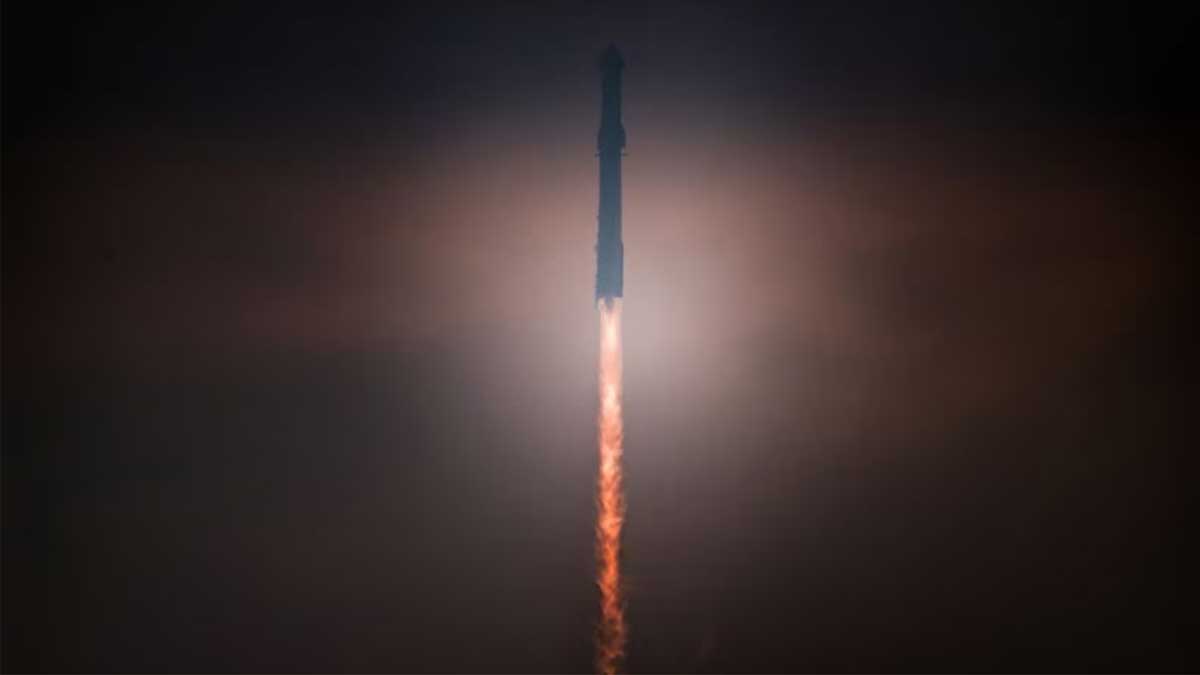- Home
- Billionaires
- Investing Newsletters
- 193CC 1000
- Article Layout 2
- Article Layout 3
- Article Layout 4
- Article Layout 5
- Article Layout 6
- Article Layout 7
- Article Layout 8
- Article Layout 9
- Article Layout 10
- Article Layout 11
- Article Layout 12
- Article Layout 13
- Article Layout 14
- Article Sidebar
- Post Format
- pages
- Archive Layouts
- Post Gallery
- Post Video Background
- Post Review
- Sponsored Post
- Leadership
- Business
- Money
- Small Business
- Innovation
- Shop
Recent Posts
SpaceX’s Starship Completes First Successful Splashdown

SpaceX launched its Starship rocket on Thursday, achieving the spacecraft’s first successful reentry into Earth’s atmosphere after three previous attempts. This milestone marks a significant step for the Elon Musk-owned aerospace firm, which aims to use reusable rockets for more frequent space travel.
The Starship, along with its Super Heavy booster, lifted off from SpaceX’s Texas site shortly after 8:50 a.m. EDT. About an hour after launch, the spacecraft reentered Earth’s atmosphere, initiating its first landing burn above the Indian Ocean. Meanwhile, the Super Heavy booster successfully landed in the Gulf of Mexico for the first time, approximately eight minutes after launch.
During the flight, Starship followed a trajectory similar to previous test flights. It began with an ascent, then lit its upper engines to propel into space, coasted in orbit, and later reentered Earth’s atmosphere. Communication with Starship was briefly lost about 13 minutes after launch as the spacecraft reached orbital velocity, but contact was restored around 24 minutes later. SpaceX broadcasted the entire launch and journey exclusively on its channel on X.
Starship reached a velocity of approximately 16,435 miles per hour as it coasted above Earth’s atmosphere.
SpaceX has conducted three previous launches of Starship since last year. The spacecraft’s debut flight in April lasted just four minutes due to a failure in stage separation. A second test flight in November lasted about eight minutes, ending in a “rapid unscheduled disassembly.” The third test flight in March saw Starship nearly reenter Earth’s atmosphere, but communication was lost, and the spacecraft crash-landed in the Indian Ocean. Despite these setbacks, SpaceX considers these missions successful as they provide valuable data on how the spacecraft handles orbital velocity and atmospheric entry.
Both SpaceX and Boeing have been contracted by NASA to develop spacecraft for crewed missions to the International Space Station (ISS), the moon, and Mars. Boeing’s crewed Starliner spacecraft is scheduled to dock at the ISS on Thursday following a launch on Wednesday, after years of delays. The objectives for Starliner include performing hatch opening and closing operations and configuring the spacecraft to the ISS, according to NASA.
Recent Posts
Categories
- 193 Countries Consortium Partner1
- 193cc Digital Assets2
- 5G1
- Aerospace & Defense48
- AI37
- Arts3
- Banking & Insurance11
- Big Data3
- Billionaires1,467
- Boats & Planes1
- Business332
- Careers13
- Cars & Bikes79
- CEO Network1
- CFO Network17
- CHRO Network1
- CIO Network1
- Cloud10
- CMO Network18
- Commercial Real Estate7
- Consultant1
- Consumer Tech194
- CxO1
- Cybersecurity73
- Dining1
- Diversity, Equity & Inclusion4
- Education7
- Energy8
- Enterprise Tech29
- Events11
- Fintech1
- Food & Drink2
- Franchises1
- Freelance1
- Future Of Work2
- Games149
- GIG1
- Healthcare79
- Hollywood & Entertainment203
- Houses1
- India’s 1000 Richest1
- Innovation46
- Investing2
- Investing Newsletters4
- Leadership65
- Lifestyle11
- Manufacturing1
- Markets20
- Media327
- Mobile phone1
- Money13
- Personal Finance2
- Policy569
- Real Estate1
- Research6
- Retail1
- Retirement1
- Small Business1
- SportsMoney42
- Style & Beauty1
- Success Income1
- Taxes2
- Travel10
- Uncategorized14
- Vices1
- Watches & Jewelry2
- world's billionaires1,436
- Worlds Richest Self-Made Women2
Related Articles
2025: A Crucial Year for Boeing’s Recovery and Future
The coming year will be critical for Boeing as it strives to...
By 193cc Agency CouncilDecember 28, 2024Friendly Fire and Drone Threats Disrupt Global Airspace
Over the past week, three very different incidents have drawn attention to...
By 193cc Agency CouncilDecember 27, 2024Universe Expanding Faster Than Expected, New Data Shows
Recent findings from the James Webb Space Telescope (JWST) have confirmed something...
By 193cc Agency CouncilDecember 10, 2024Russian Soldier Life Expectancy: One Month Amid Losses
In the ongoing war between Russia and Ukraine, a stark reality faces...
By 193cc Agency CouncilNovember 29, 2024















Leave a comment